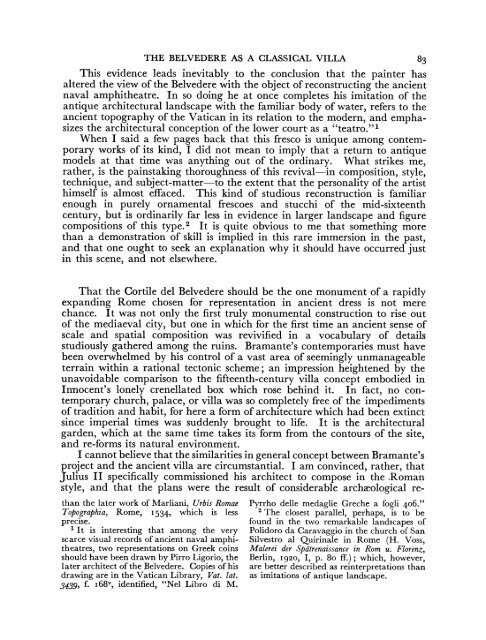The Belvedere as a Classical Villa
The Belvedere as a Classical Villa
The Belvedere as a Classical Villa
You also want an ePaper? Increase the reach of your titles
YUMPU automatically turns print PDFs into web optimized ePapers that Google loves.
THE BELVEDERE AS A CLASSICAL VILLA 83<br />
This evidence leads inevitably to the conclusion that the painter h<strong>as</strong><br />
altered the view of the <strong>Belvedere</strong> with the object of reconstructing the ancient<br />
naval amphitheatre. In so doing he at once completes his imitation of the<br />
antique architectural landscape with the familiar body of water, refers to the<br />
ancient topography of the Vatican in its relation to the modern, and empha-<br />
sizes the architectural conception of the lower court- <strong>as</strong> a "teatro."'<br />
When I said a few pages back that this fresco is unique among contem-<br />
porary works of its kind, I did not mean to imply that a return to antique<br />
models at that time w<strong>as</strong> anything out of the ordinary. What strikes me,<br />
rather, is the painstaking thoroughness of this revival-in composition, style,<br />
technique, and subject-matter-to the extent that the personality of the artist<br />
himself is almost effaced. This kind of studious reconstruction is familiar<br />
enough in purely ornamental frescoes and stucchi of the mid-sixteenth<br />
century, but is ordinarily far less in evidence in larger landscape and figure<br />
compositions of this type.2 It is quite obvious to me that something more<br />
than a demonstration of skill is implied in this rare immersion in the p<strong>as</strong>t,<br />
and that one ought to seek an explanation why it should have occurred just<br />
in this scene, and not elsewhere.<br />
That the Cortile del <strong>Belvedere</strong> should be the one monument of a rapidly<br />
expanding Rome chosen for representation in ancient dress is not mere<br />
chance. It w<strong>as</strong> not only the first truly monumental construction to rise out<br />
of the mediaeval city, but one in which for the first time an ancient sense of<br />
scale and spatial composition w<strong>as</strong> revivified in a vocabulary of details<br />
studiously gathered among the ruins. Bramante's contemporaries must have<br />
been overwhelmed by his control of a v<strong>as</strong>t area of seemingly unmanageable<br />
terrain within a rational tectonic scheme; an impression heightened by the<br />
unavoidable comparison to the fifteenth-century villa concept embodied in<br />
Innocent's lonely crenellated box which rose behind it. In fact, no con-<br />
temporary church, palace, or villa w<strong>as</strong> so completely free of the impediments<br />
of tradition and habit, for here a form of architecture which had been extinct<br />
since imperial times w<strong>as</strong> suddenly brought to life. It is the architectural<br />
garden, which at the same time takes its form from the contours of the site,<br />
and re-forms its natural environment.<br />
I cannot believe that the similarities in general concept between Bramante's<br />
project and the ancient villa are circumstantial. I am convinced, rather, that<br />
Julius II specifically commissioned his architect to compose in the .Roman<br />
style, and that the plans were the result of considerable archaeological re-<br />
than the later work of Marliani, Urbis Romae<br />
Topographia, Rome, 1534, which is less<br />
precise.<br />
I It is interesting that among the very<br />
scarce visual records of ancient naval amphitheatres,<br />
two representations on Greek coins<br />
should have been drawn by Pirro Ligorio, the<br />
later architect of the <strong>Belvedere</strong>. Copies of his<br />
drawing are in the Vatican Library, Vat. lat.<br />
3439, f. 168v, identified, "Nel Libro di M.<br />
Pyrrho delle medaglie Greche a fogli 406."<br />
2 <strong>The</strong> closest parallel, perhaps, is to be<br />
found in the two remarkable landscapes of<br />
Polidoro da Caravaggio in the church of San<br />
Silvestro al Quirinale in Rome (H. Voss,<br />
Malerei der Spdtrenaissance in Rom u. Florenz,<br />
Berlin, 1920, I, p. 8o ff.); which, however,<br />
are better described <strong>as</strong> reinterpretations than<br />
<strong>as</strong> imitations of antique landscape.



